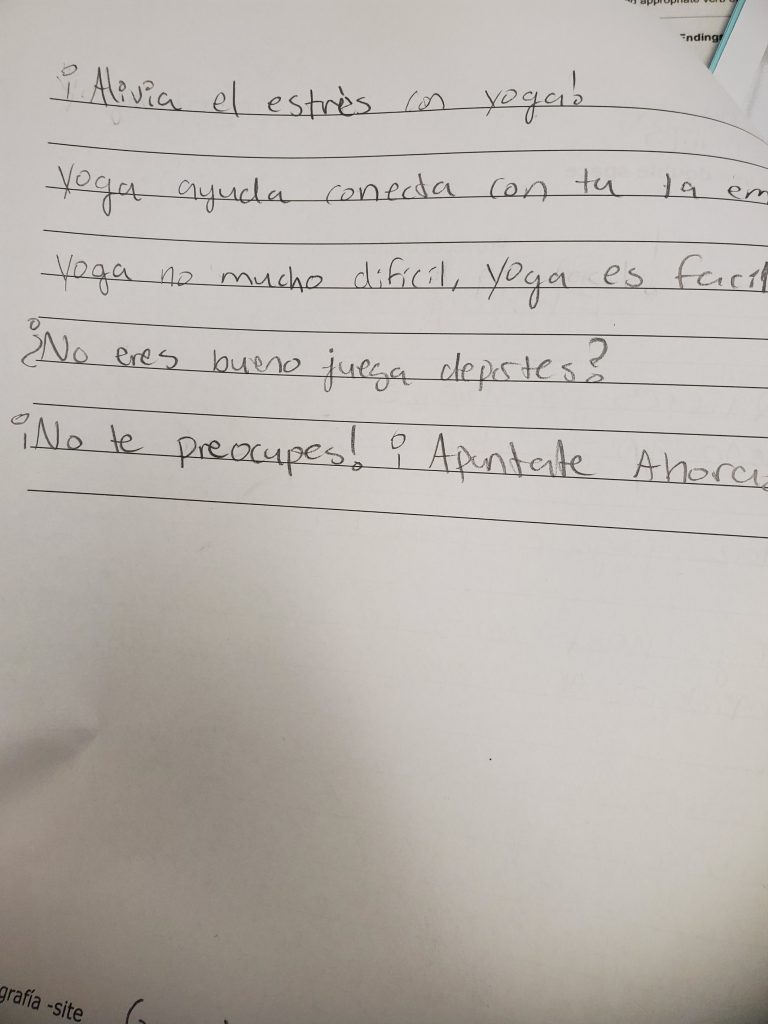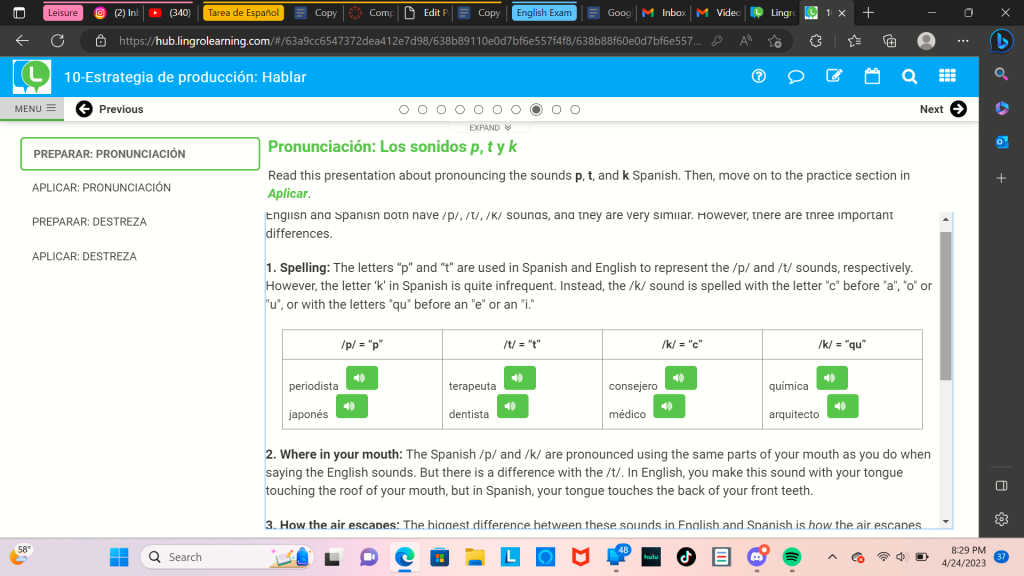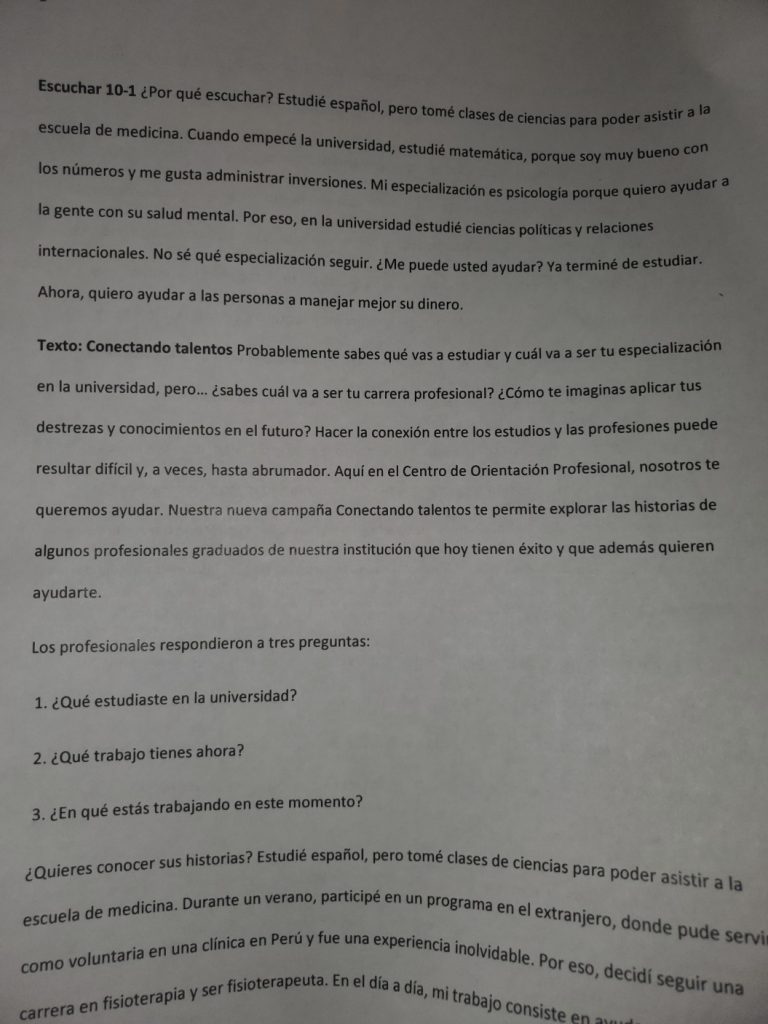Interpretive, Interpersonal, and Presentational Modes of Communication
Exploring Culture
Throughout our textbook; Contraseña we’ve explored different Spanish-speaking countries. This exploration involved food, family, and even sports. These activities helped me better understand how society in Spanish-speaking countries differs from the U.S. For example, while women in sports are pretty common in the U.S., in some Hispanic countries, Women’s sports are not as popular.
I had never made any stereotypes regarding Spanish-speaking countries, but I did assume that when it came to sports most countries would consider it common for women to be in sports. But I do understand that different countries have different customs and view systems.
Engaging in Communities
It’s very important to engage in your immediate and global community so you can learn and give back. What I mean by that is that if you engage within your immediate and global communities you can learn about your history and culture on a wider scale. When it comes to giving back, I just mean that you can help out your community or help your people. There are many different types of communities too, as being a college student, you have a community with your classmates. You can also exchange ideas with other people.
Below is a document when I was coming up with questions to ask my speaking partner for our project.
Interpersonal Communication
With TalkAbroad we get to choose who we would like to speak with to have a conversation. The conversations we had this semester revolved around family and food. The conversations are supposed to be around 15 minutes long with you hopefully doing 60% of the talking. In Contraseña we were given activities where we had to type of out words instead of just selecting an answer. In the classroom itself, we would read different documents revolving around the current topic we’re learning.
I would say I’ve grown when from the activities. The TalkAbroad’s I feel made me feel more comfortable and confident in myself when having conversations in Spanish. I do tend to be nervous when it comes to writing in Spanish because I worry if I’m putting an accent where not needed, needing an accent and not putting one, or just simply misspelling the word. I do also at times confuse conjugations for certain words. I think I do best when it comes to adjectives or when talking about myself. It has been difficult, but I hope to improve more as I continue with Spanish next semester!

Presentational Speaking
The speaking activities I’ve done this semester inside and outside the classroom has been projects where I had to record myself speaking and my TalkAbroad conversations. These activities did make me nervous since I’m not 100% confident in my speaking abilities since Spanish is not my native language. But the more I go through them they become a little less nerve wracking.
What really challenged me is the TalkAbroads. I do have social anxiety so it can be nerve-wracking to talk to strangers. So, having to get on a video chat and talk to a stranger from a different country and speak another language, was definitely stressful for me. To help myself out I came up with a list of questions as well as responses I could give if those same questions were asked back to me. For my first TalkAbroad I didn’t study so I still did good, but I was super nervous and unprepared, so I didn’t do as well as I could’ve.
https://linksharing.samsungcloud.com/dE4D7fXatlM2
Presentational Writing
Throughout the semester we’ve looked through flyers, infographics, and various forms of writing. One of the infographics we had looked at gave information preventing mental physical illnesses. They listed symptoms of the illness and even ways to prevent the illness, if it was physical. Or if it was a mental illness, they list symptoms and ways to manage the illness. For my own project I talked about symptoms and how to manage anxiety.
The most difficult part of the infographic was trying to describe symptoms and preventions in Spanish. It’s easy to describe these things in English, but in Spanish I wasn’t sure how to form the sentences since I didn’t know a lot of transition words, or words in general. How it became easier is that I realized I could try my best and ask for help from my professor if needed. To do better next time, I should research how to certain words in Spanish.

Interpretive Listening
As for listening activities I’ve done this semester, there have been activities completed in Contraseña where we have to listen to certain words and say what letter they are pronounced with or what word they are saying. There are also instances where we have to choose what tense the word is being said in while the speaker is talking.
What was most interesting about these activities to me was how different English and Spanish. Now I know that’s obvious but what I mean is how “v” and “b” can have the same pronunciation with certain words in the Spanish language. As far as I know the English language doesn’t have many occurrences like that. I think it’s good to hear native speakers pronounce these things because it helps you get an idea of how to say it.

Interpretive Reading
Activities that I’ve completed this semester regarding reading are the papers that have been passed out to us in class or the readings within Contraseña itself. These readings described professions, sicknesses, families, and even recipes.
I have definitely grown a lot this semester. With this being Spanish 102, it’s a little more advanced than level one but we’re still in the “Novice “category. With that being said, I feel that I’m becoming a better speaker with the language. Practicing reading words in Spanish helps me to know how to pronounce certain words. Each assignment brings me closer and closer to becoming more knowledgeable of the language, and I’m excited to learn more in Spanish 201!

